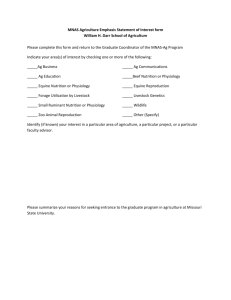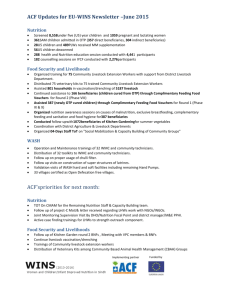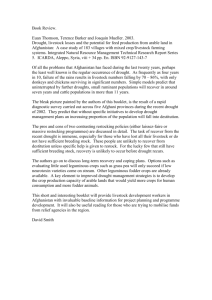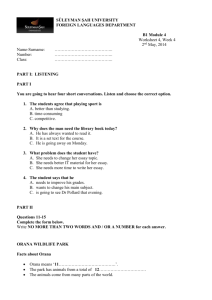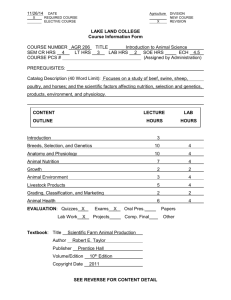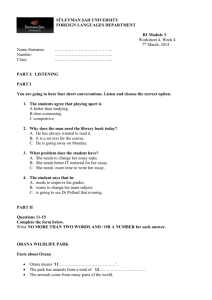Report on the Food and Nutrition Situation
advertisement
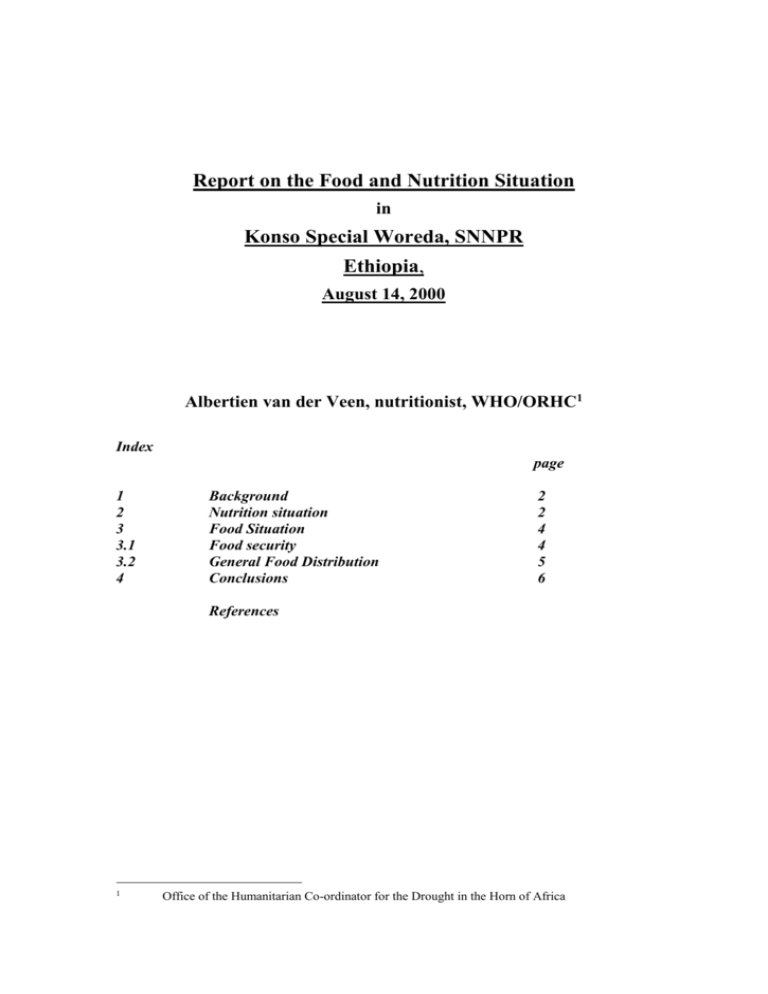
Report on the Food and Nutrition Situation in Konso Special Woreda, SNNPR Ethiopia, August 14, 2000 Albertien van der Veen, nutritionist, WHO/ORHC1 Index page 1 2 3 3.1 3.2 4 Background Nutrition situation Food Situation Food security General Food Distribution Conclusions 2 2 4 4 5 6 References 1 Office of the Humanitarian Co-ordinator for the Drought in the Horn of Africa 1. Background The objective of this report is to provide an overview of the food security and nutrition situation in Konso special woreda and the humanitarian response thus far, outline existing problems if any and to provide recommendations for action. The methodology for this assessment consisted firstly of the collation of various survey and assessment reports of non-government organisations (NGOs), DPPC and United Nations (UN) agencies. This was followed by a field visit to Konso Special wereda. Information was gathered from local officials as well as from NGOs. Konso special woreda, situated about 600 km south of Addis Ababa consists of some 1,800 km². The population according to adjusted 1994 census figures, is approximately 170,000, but is generally believed to be over 200,000. Over 90% of the population depends on agriculture, essentially relying on rain rather than irrigation. Located in the semi-arid ecological zone with erratic rainfall, Konso suffers from drought induced famines almost once every ten year. The last two droughts hit Konso in 1973/1974 and in 1984/85. This year for the third consecutive time, the belg rains have failed, resulting in nearly 100% crop loss of sorghum and maize. The humanitarian response is co-ordinated by the Drought Management Committee (DMC) that advocates food for work -called Employment Generating Schemes (EGS)rather than free food distribution as the preferred strategy to improve food security and mitigate the impact of the drought. The Committee consists of representatives of the DPPB, Woreda Council, Bureau of Health (BOH), Konso Development Association and international and national NGOs, providing assistance in the food (security), health and nutrition sectors. Humanitarian response is based on comprehensive assessments in combination with bottom-up information from peasants’ associations to the DMC and other stakeholders. 2. Nutrition Situation The nutrition surveillance programme (NSP)2 does not cover Konso. Following a UN/DPPC assessment mission in July 1999, which expressed serious concern at the effects of the drought in Konso, the Woreda Council and Farm Africa3 requested MSF-H4 to carry out a nutrition survey. Together with staff from the BOH and other governmental offices, MSF-H conducted a 30 clusters base-line nutrition survey in August 1999. The survey aimed to determine the malnutrition prevalence, analyse underlying causes of malnutrition and recommend on appropriate interventions. The survey revealed a prevalence of 20,2% global malnutrition (of which 1,2% severe) and 2 3 4 The NSP is a longitudinal monitoring system that utilises a standard set of food security, agricultural and anthropometric indicators to track changes over time. In many regions of Ethiopia, the early warning department of the DPPC in conjunction with SCF-UK monitors the nutrition and food security situation through this (NSP). Implementing a programme to improve food security At the time assisting the ministry of health (MOH)/Bureau of Health in visceral leishmaniasis (kala-azar) control in Konso. deteriorating food security. Households at the time had started to sell productive assets including livestock and to consume wild foods. Lack of water and health problems were found to be important contributing factors to malnutrition. In response, MSF-H in October 1999, launched a dry supplementary feeding programme for malnourished children under five years and pregnant and lactating mothers, providing 2 kg Faffa (blended food) per week at 21 sites throughout Konso Woreda. Half of the sites were health posts (9 governmental). The programme also included medical support to these health facilities, medical services in other places, as well as micro-nutrient supplementation. In addition, the Ethiopian Evangelical Church Mekan Yesus (EEC/MY) that runs a health clinic in Konso town, extended its nutrition rehabilitation centre to better cater for severely malnourished children with logistic, medical and management support from MSF. A follow-up 30 cluster survey was carried out in January 2000 in order to evaluate the drought response programme and to further fine-tune feeding programmes, if necessary. The survey also aimed to monitor household food security and recommend appropriate strategies to strengthen existing programmes (for details refer to section 3). Results of this survey showed, that global malnutrition had decreased to 12.9% (of which 2,0% severe. Diseases, in particular diarrhoeal diseases and ARI, continued to be an important underlying cause; 47% of the under fives had been ill during the 15 days preceding the survey. Significantly more malnourished children (63%) than non-malnourished (44%) had been ill. In view of reports of an increase in measles from neighbouring woredas, the survey also assessed measles immunisation coverage. Coverage was only 24,5%, of whom a mere one out of four had documented evidence of being immunised. Lastly, the survey revealed that two out of three malnourished children were not receiving supplementary food, despite MSF's intervention. In response to this second survey, supplementary feeding in combination with a mobile clinic providing health care was extended to include 10 more sites. Since February 2000, an average of 4,600 children and 2,400 PNW are covered through the programme. Also, to better cater for a sharp increase in the caseload of severely malnourished (due to better case-finding rather than an increase in prevalence as can be concluded from the nutrition surveys), MSF opened an additional TFC in April 2000. The number of attendants has steadily increased from around 40 in May to an average of 70 in July; but, overall numbers have remained modest due to: decentralised ongoing supplementary feeding throughout the whole woreda referral of moderately malnourished children failing to gain weight on supplementary feeding alone to the nutrition rehabilitation unit of EEC/MY excellent care including 24 hours care throughout the treatment period resulting in an average recovery period of less than three weeks an low defaulting rates The average number of malnourished children in the EEC/MY nutrition rehabilitation unit is about 40. Twenty-four hour care is not yet provided, but staff has been recruited and full care is expected to start soon. Also in response to the follow-up survey, the BOH and MSF carried out a mass measles vaccination campaign in April during which approximately 22,000 children aged six months to five years of age, estimated to correspond to about 80% of the target group were immunised and provided with vitamin A. A second campaign targeting children between 9 and 12 month of age will be carried out next month. A second follow-up nutrition survey planned for August 2000, is expected to provide information on the current prevalence of malnutrition, the effectiveness of the response, and strategies for further improvement, if necessary. 3. Food and Food Security 3.1 Food Security Even at the best of times less than 30% of the population in Konso is self-sufficient in food from their own produce. With a population density of 130/km², more than 50% of the farmers cultivate less than 0.25 hectare, which in a good year is only sufficient to feed one household for approximately six months. Belg harvest accounts for about 70% of the overall production. The average number of livestock per household is 2 cattle, 3 sheep and 2 goats. Perspectives for improving household food security are not good either due to continuing erosion and population growth. Seasonal outmigration to more prosperous neighbouring woredas is a normal coping strategy. Others strategies are petty trade, weaving of cotton, sale of livestock and reducing the number of meals. Failure of the meher harvest in 1999 severely impacted on household food security. According to the base-line nutrition survey in August 1999, only one out of every four households collected meher harvest. On average, quantities collected were only sufficient for three months. In January 2000, 17% of the population was relying solely on its own food production, as opposed to over 80% normally. More than 70% of the population depended on EGS and purchase from the market as opposed to 14% in years when harvests are good. Cereal prices were higher than usual, and livestock prices lower especially cattle (all kinds including cows, oxen and heifers). Nearly 20% of the households stated they were selling livestock to buy cereals. Higher than usual out-migration, lack of seeds, inability to pay back debts incurred as a result of the purchase of improved seeds and fertiliser for the previous harvest, as well as the poor condition of ploughing animals were perceived as major constraints in preparing for the next season. In response to the survey findings, Farm Africa provided maize, sorghum, teff and haricot beans seeds to some 17,000 households. In March 2000, Farm Africa also conducted a livestock survey in order to better understand the role of livestock in food security in Konso and to gather base-line information. The survey focussed on: livestock ownership and management, animal feeding practices animal health problems encountered and potential solutions Apart from other useful data, the survey also revealed that during the year preceding the survey, some 8% of livestock had died due to lack of pasture (cattle: 13%, sheep: 8% and goats: 5%). Although livestock sales were substantial, only 6% of the interviewed households sold animals due to a lack of pasture. The area is known for endemic livestock diseases (in particular trypanosomiasis, foot and mouth disease, and anthrax), which in times of drought increase due to increased livestock movement and subsequent disease transmission. Survey findings indicate that although diseases in combination with poor veterinary services and unaffordable drugs was an important constraint, on average less than 6% of livestock had died due to disease. Because the survey was the first to attempt to establish base-line data for the wereda, it was not possible to draw conclusions as to whether such losses were different and to which extent from normal losses. In the year 2000, belg rains started late. Some modest hope at the beginning of the rainy season shattered as rains stopped in May and have not resumed to date. Maize and sorghum, planted in the mid- and lowlands south of Arba Minch in late July, appeared to have completely withered and are now being used as livestock feed. At present, Farm Africa estimates a more than 90% crop failure of maize and green beans. Because the next harvest depends on satisfactory belg harvest, due to the habit to ratoon rootstocks rather than sow again, prospects for the meher harvest are also grim. Livestock loss has reportedly increased, but firm data are lacking. 3.2 Food Distribution Until September 1999, limited food distribution was carried out by DPPC5. Drought affected households, at the time estimated at approximately one-third of the population (60,000 people) received on average less than 5 kg per person per month in the February-June period. In response to the first nutrition survey, in September 1999, Farm Africa geared its food security programme essentially consisting of capacity building and income generation, towards the provision of food through Employment Generating Schemes; they effectively took over food distribution from DPPC. At present, some 33,000 households (approximately 150,000 people) are employed in EGS. The programme is implemented in 30 of the 31 kebelles in Konso Special Wereda. Seven have been included only recently. In the latter ones, about 30% of the potential beneficiaries are employed, while in the other 23 kebelles 100% of the needs are covered. Activities carried out as part of the EGS consist of the construction of secondary roads, small-scale irrigation schemes, flood control works, fencing, houses for teachers etc.. Payment consists of 3 kg of cereals per person, per day of work. In addition, some 5,000 elderly, disabled and other vulnerable groups, who are unable to work, receive free food. From November 1999 onwards, Farm Africa has been providing on average some 1500 MT/month, or 8.5 kg per person per 5 DPPC received more than half of this food from Norwegian Church Aid and EEC/MY-LWS. month6. As of June 2000, the amount has increased to 2200 MT/month (corresponding to about 11 kg per person per month). In view of the failed belg crop, the NGO envisages extending EGS until December 2000, instead of September, as planned earlier. 4. Conclusions Efforts in Konso to mitigate the effects of the drought appear to have been largely successful. Malnutrition rates have dropped considerably during the latter half of 1999 despite failure of both the belg and the meher harvests. As of yet, there are no indications that the situation has (substantially) deteriorated. This success can be related to strong co-ordination by the Drought Mitigation Commission, and a timely response. In the absence of a comprehensive early warning and nutrition surveillance system, the Woreda Council and others which later established the DMC, sought an alternative approach for measuring the impact of the drought at an early stage, by requesting an INGO to conduct a comprehensive nutrition survey in August 1999. Based on this survey, humanitarian response considerably increased, not least because a number of agencies were already present in the woreda and were willing to adjust their programmes and/or initiate new drought response programmes. Because these agencies covered the health and nutrition as well as the food and food security sectors among them, a multi-track response could be developed in a relatively short time. Furthermore the response continues to be adjusted according to needs by means of follow-up surveys in January and August 2000, in combination with bottom-up information from peasants’ associations to the DMC and other stakeholders. The therapeutic and supplementary feeding programmes implemented by MSF H and EEC/MY are of excellent quality, as can be measured by short recovery periods and low defaulting rates. Whether adjustment of the programme in January 2000, has also positively impacted on morbidity is less clear, but will be revealed by the next followup. The Employment Generation Schemes programme implemented by Farm Africa is combined with distribution of seeds and a livestock program. This strategy clearly appears more effective in assisting the restoration of the population’s livelihoods at the medium long term, than free food distribution alone In summary, through appropriate co-ordination mechanisms, concerted efforts of NGOs, church based organisations and government officials, high quality programmes and close monitoring of the situation, drought response has so far has been quite effective. 6 Interestingly, findings by MSF from their nutritional survey confirm that ESG in February had a coverage of about 80%, providing families employed with on average 8.5 kg of cereal per person per month. Free food rations consisted of only 3.3 kg per person per month however. References - Konso Special Woreda Baseline Nutrition Study, MSF Holland, Addis Ababa September, 1999. - North Omo Zone, Derashe and Konso Special Weredas of Southern Nations and Nationalities and People region, Report on Rapid Assessment Mission 31 May – 7 June 2000, UN-EUE, June 2000. - Nutritional status and Food Security Assessment, Konso Special Woreda, MSF Holland, February, 2000. - Rapid Assessment Report: Konso Special Wereda, SNNPR, UN-EUE, August, 1999 - (Draft) Report on the Livestock Feed and Health Survey, Farm Africa, Konso, July, 2000 DISCLAIMER The designations employed and the presentation of material in this document do not imply the expression of any opinion whatsoever of the UN concerning the legal status of any country, territory, city or area of its authorities, or concerning the delimitation of its frontiers or boundaries. 22 August, 2000
